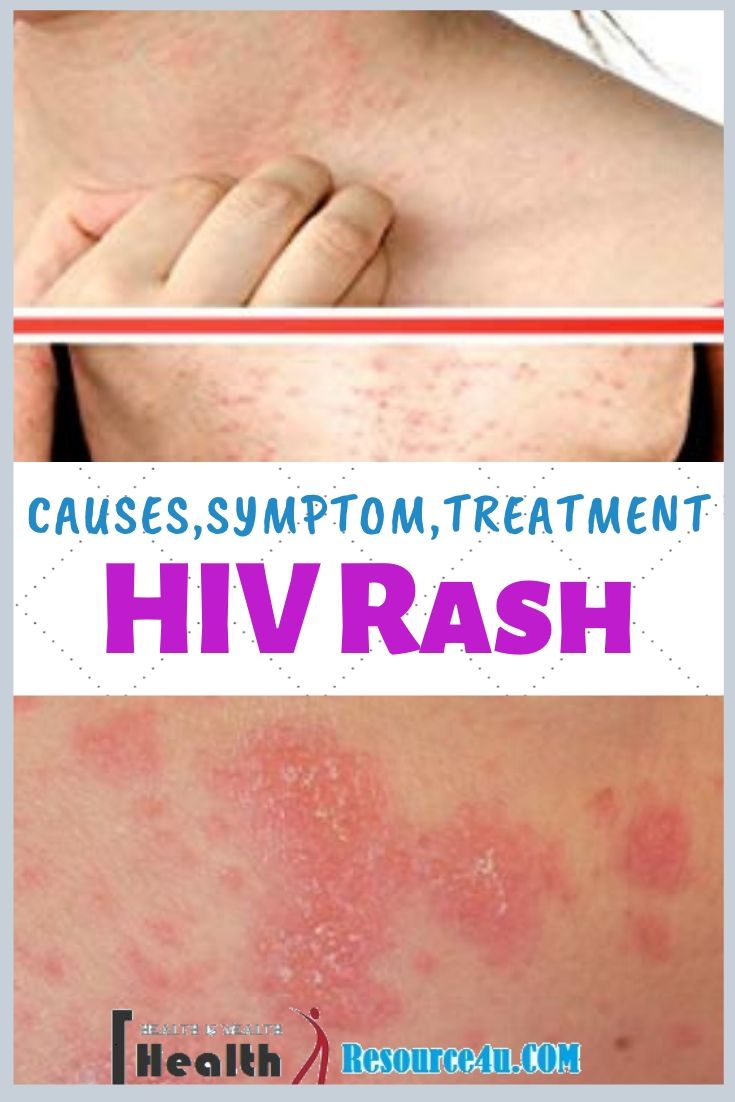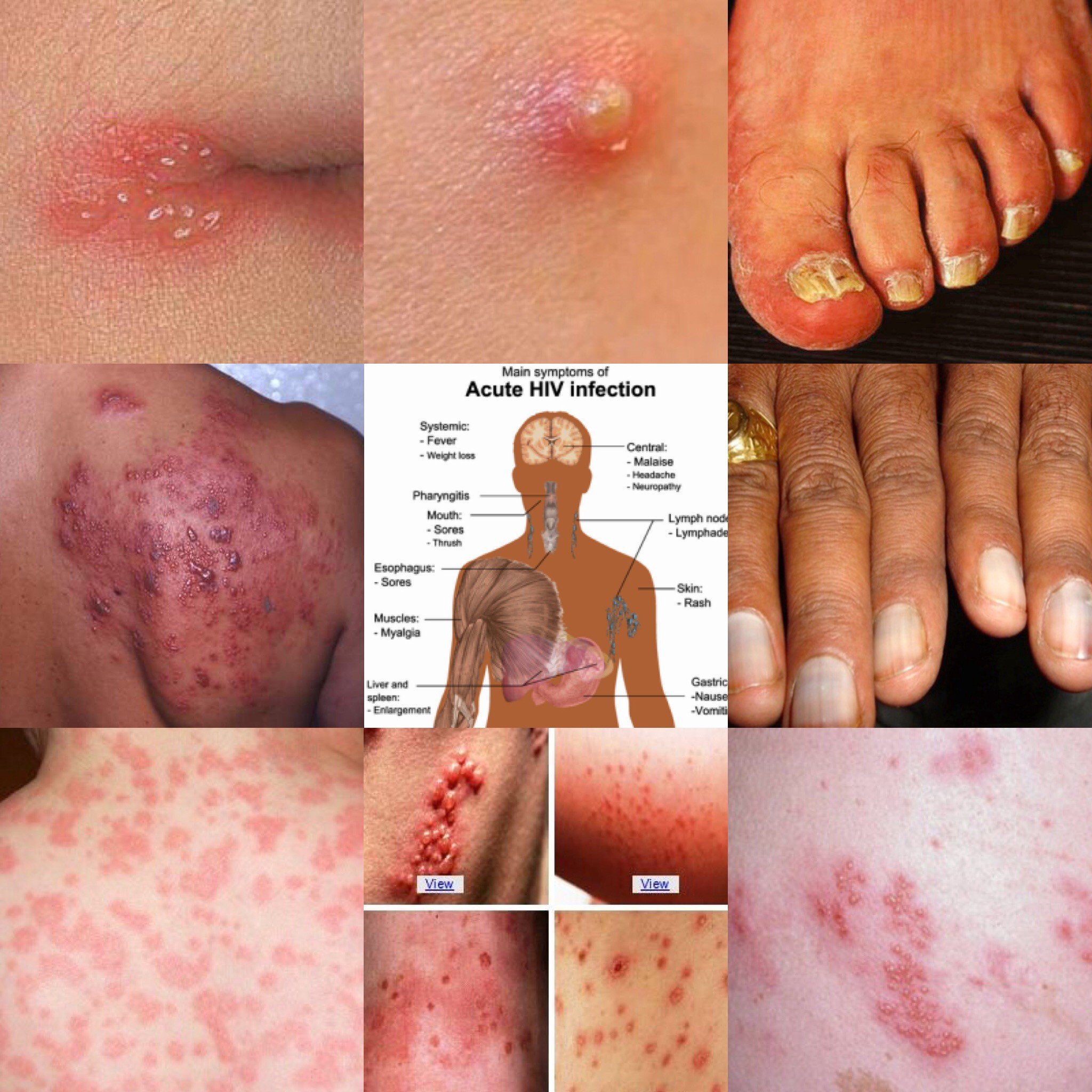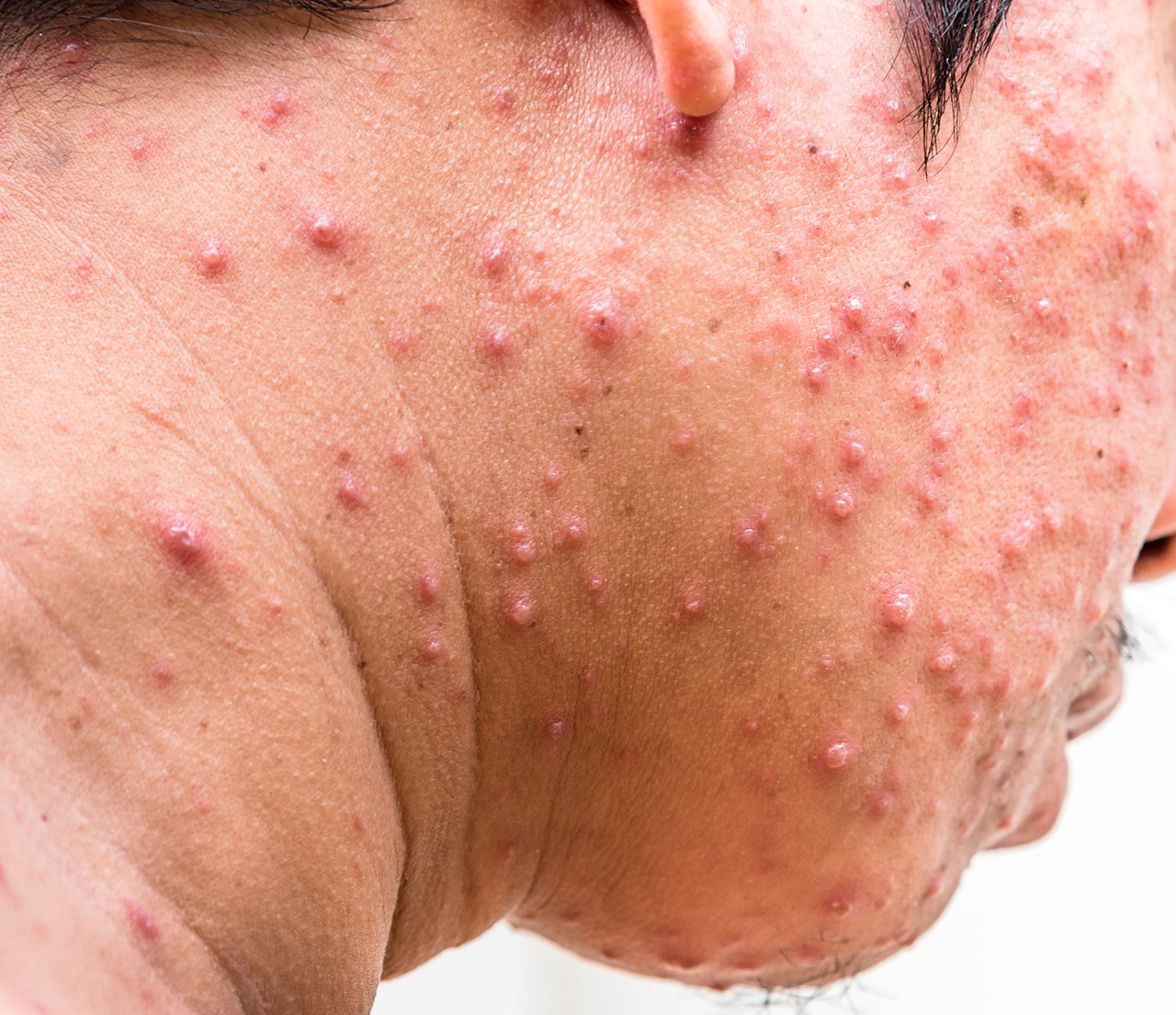Who Gets Skin Disease In Hiv
Dermatological conditions are extremely common during HIV infection and will affect approximately 90% of all people living with HIV. These conditions can be both specific to HIV, as well as common skin problems found in the general population.
Cutaneousmanifestations will generally increase in incidence with advancing HIV disease and declining immune function, causing significant morbidity. Hence, early recognition and testing in patients presenting with such conditions may allow HIV infection to be diagnosed and treated earlier.
Hiv Rash: What Does It Look Like And How Is It Treated
We include products we think are useful for our readers. If you buy through links on this page, we may earn a small commission. Heres our process.
Rash as an early symptom of HIV
A rash is a symptom of HIV that usually occurs within the first two months after contracting the virus. Like other initial symptoms of HIV, its easy to mistake this rash for a symptom of another viral infection. Therefore, its important to learn how to identify this rash and how to treat it.
Is It Safe For Children With Hiv To Receive Routine Immunizations
-
MMR, or measles, mumps, and rubella vaccine, is safe to give to children with HIV, unless they have a severely weakened immune system.
-
DTaP/Td vaccine is safe to give to infants and children with HIV.
-
Hib and Hep B vaccines are safe to give to children with HIV.
-
Hepatitis A and B vaccines are safe to give to HIV-positive children.
-
VZIG should be considered for known HIV-positive children, depending on their immune status.
-
A yearly influenza vaccine is recommended for children with HIV, as well as any individual living in the same household as a child with HIV. There are two types of influenza vaccine children and adults with HIV should receive the shot form of the vaccinenot the nasal spray form, as it contains a live virus. Pneumococcal vaccine can be safely administered to age-appropriate HIV-infected children.
Always consult with your childs doctor regarding immunizations for an HIV-infected child.
Read Also: How Long Can You Have Hiv Without Knowing
Hiv And Aids Timeline
From the bleakest early days of the epidemic, Johns Hopkins has been a leader in understanding, treating and preventing HIV and AIDS. Explore 35 years of progress, here and around the world, including the nations first HIV-positive to HIV-positive organ transplants, performed at The Johns Hopkins Hospital in 2016.
Noninfectious And Nonmalignant Cutaneous Manifestations Of Hiv Infection

For xerosis, emollients and dry skin care regimens are effective. For seborrheic dermatitis, coal tar, sulfur, and salicylic acid shampoos topical corticosteroids topical tacrolimus and 2% ketoconazole cream may be effective.
For psoriasis and Reiter syndrome, ultraviolet B and psoralen with UV-A may be useful. Systemic corticosteroids, methotrexate, and cyclosporine may increase the immune suppression and must be considered only with careful monitoring. Zidovudine is also reported to be useful in the treatment of HIV-associated psoriasis.
For pruritic papular eruption, topical steroids, UV-B, PUVA, and pentoxifylline have been reported to be effective. Eosinophilic folliculitis may respond to UV-B, isotretinoin, or zidovudine treatment. For severe aphthous stomatitis, tacrolimus is reported to be effective.
Also Check: Highest Hiv Rate Cities In Us
Manifestations By Hiv Disease Stage
During acute primary HIV infection, a transient, generalized, morbilliform eruption may develop on the trunk and the arms. In the early asymptomatic stage of HIV disease, which may last from a few years to a decade or longer, no signs of infection other than lymphadenopathy are present. In a survey of 165 children in India with HIV infection, cutaneous manifestations were evident in 100 of them. Papular pruritic eruptions were evident in 16%, the most common condition, with highest prevalence in severe CD4 category. In one survey of 106 West African patients, the pruritic papular eruptions of HIV infection were mainly on the exposed parts of the body, especially the upper and lower limbs.
Kaposi sarcoma can occur prior to the onset of immunosuppression. With the onset of immunosuppression, nonspecific skin changes occur, such as common disorders with atypical clinical features, including recurrent varicella zoster, numerous hyperkeratotic warts, treatment-resistant seborrheic dermatitis, and oral hairy leukoplakia. However, Kaposi sarcoma of skin and/or oral cavity may develop in HIV patients with well-controlled HIV disease and may be a significant factor in their morbidity and mortality.
Skin Conditions Associated With Aids
Many common skin conditions that occur in healthy individuals also occur in people infected with HIV, but they are frequently more severe and may be more difficult to treat. One or more of these skin conditions may be the first indicator of an immune disorder related to an underlying infection with HIV. Therefore, it is necessary to seek the advice of a dermatologist for evaluation, diagnosis, and treatment.
Don’t Miss: Can You Die Of Aids
What Does An Hiv Rash Look Like
Usually HIV infection leads to a brief period of symptoms shortly after infection occurs. Not everybody notices these symptoms, and theyre easy to mistake for a cold or the flu. One of the symptoms may be a rash.
The most common HIV rash occurs shortly after infection. It is an itchy rash that usually appears on the abdomen, face, arms, or legs and features a flat, red area covered in small red bumps.
Hairy Leukoplakia Of The Mouth
This unusual condition appears as small, white, fuzzy patches that most often develop on the tongue. It is believed to be caused by a member of the herpes family of viruses known as the Epstein-Barr virus. Hairy leukoplakia resembles thrush, a yeast infection of the mouth. The lesions of hairy leukoplakia are painless. It is an important signal that the patient is probably infected with HIV.
Don’t Miss: Aids Life Expectancy With Treatment
What Can Effective Hiv Treatment Do
HIV medication keeps you healthy so you can live a normal lifespan.
Treatment can also reduce your viral load to undetectable levels so that you wont be able to pass on HIV to anyone else. It can take up to six months from starting treatment to become undetectable, so its important to test and start treatment on time.
Molluscum Contagiosum Top Of Page
Molluscum contagiosum is almost as prevalent as warts. In people with AIDS, molluscum may be very widely distributed, especially on the face and neck, and much more difficult to control. Molluscum can be distinguished from warts by several features. Molluscum papules tend to be dome-shaped and to have a certain translucence. In better-developed lesions, there is often an umbilication. Histologically, the papules contain protein and viral particles known as molluscum bodies. Unlike warts, molluscum, which are caused by a pox virus, do not occur in the mouth or anorectal mucosa and have no known oncogenic potential.
Read Also: How Was Hiv First Introduced
Seborrheic Dermatitis Psoriasis And Tinea Top Of Page
Seborrheic dermatitis, psoriasis and tinea are often confused with one another. Seborrheic dermatitis is another condition that appears to occur more frequently in HIV disease. Characterized by erythema and rounded, itchy, scaly plaques on the scalp, the face and occasionally the chest and groin, seborrheic dermatitis is thought to be caused by a hypersensitivity reaction to fungi in hair follicles. It is usually a chronic condition that can be controlled with hydrocortisone or ketoconazole cream.
Psoriasis also produces erythema and plaques that can occur in any location. These plaques, which tend to be covered with silvery scales, typically do not itch and may, in fact, bleed when scratched. But beware: Psoriasis is not exclusively a cosmetic problem. It can cause arthritis in the joints and extremely debilitating lesions on the hand or foot. Traditional therapies do not work very well in HIV-positive patients, and topical steroids lose their effectiveness quickly. Some success has been reported with etretinate , a relative of Accutane, or PUVA . Dovonex cream has had success, especially in intretriginous and genital psoriasis. Tazarotene gel, a new retinoid, is another potential treatment for HIV-associated psoriasis.
Tinea tend to have an advancing edge, or active border, with central clearing. Scrapings are positive on KOH examination. Tinea may be treated with topical antifungals, but in more severe cases oral antifungals may be needed as well.
What Does It Look Like

The rash presents as irritated skin that is often said to be itchy, red, and painful. It most commonly appears on the arms, legs, face and abdomen . It can be red or purple, itchy and sometimes even painful. Other HIV-related skin changes include:
MyTherapy: Reminders for your meds
- Blotches on and under the skin
- White spots in the throat, in the mouth, or on the tongue
Recommended Reading: Is Hiv Transmitted Through Oral Sex
Hiv Rash On Face / Hiv Rash On Hands
Does HIV rash itch? HIV rash on the face is known as eosinophilic folliculitis and it appears on people with HIV and AIDS. One of the symptoms of it is itchy bumps on the face, hands, and upper body. Depending on the classification of the germ, it can be treated with antifungal creams or pills for yeast infections.
What To Do If You Notice An Hiv Rash
If you do notice this kind of rash and it’s associated with any other acute symptoms of HIV, you should get HIV tested immediately.
You can order an HIV test kit online from one of our doctors, and find out your status within two days.
Over-the-counter medications like Hydrocortisone Cream can be used to help heal the rash and lessen itching, but you should always seek medical advice first.
Don’t Miss: What Is Art Treatment For Hiv
Should You Be Concerned
Dont assume you have HIV just because you have a rash. An HIV rash can be similar to rashes caused by many other factors and illnesses. But if you think you may have been exposed to HIV , its a good idea to get an HIV test in order to easily tell if you have the virus.
Treatment
Rashes that occur because of acute HIV infection usually go away without treatment. Rashes caused by other conditions can usually be treated. Depending on whats causing the rash, over-the-counter drugs such as hydrocortisone cream or diphenhydramine may help reduce the rashs size and itchiness.
While an HIV rash may go away, the virus weakens the immune system, which means infectious rashes may be more likely to reappear. In addition, HIV can cause serious health complications and be life-threatening if left untreated. Knowing your status empowers you to seek antiretroviral treatment to keep yourself and your partner healthy.
Rashes as a side effect of medication can be treated or, depending on the severity, your doctor may suggest switching medicine. In these cases, discontinuing a triggering medicine can clear up the rash, but it should only be done as directed by a doctor. If youre taking HIV medicine or another medicine, keep an eye out for rashes or other side effects and talk to a doctor if you begin to experience them. If you show signs of SJS, seek immediate medical attention.
Lifestyle Changes
You can minimize irritation by:
If I Am Pregnant And Have Hiv Will My Baby Also Have Hiv
Most women with HIV can protect their baby from becoming infected during pregnancy. Proper pre-natal treatment can reduce the risk that an HIV-positive mother will pass the virus to her child to less than 1 percent. The only way these special treatments can be provided is if the health care professionals know the mother is living with HIV. Treatment is most effective when started early in pregnancy. HIV-positive moms should not breastfeed their babies because HIV is sometimes passed this way.
You May Like: How Much Is Hiv Medicine
You May Like: Where Can You Get Free Hiv Testing
Third Stage: Aids Symptoms
AIDS is the advanced stage of HIV infection. This is usually when your CD4 T-cell number drops below 200 and your immune system is badly damaged. You might get an opportunistic infection, an illness that happens more often and is worse in people who have weakened immune systems. Some of these, such as Kaposis sarcoma and pneumocystis pneumonia , are also considered âAIDS-defining illnesses.â
If you didnt know earlier that you were infected with HIV, you may realize it after you have some of these symptoms:
- Being tired all the time
- Swollen lymph nodes in your neck or groin
- Fever that lasts more than 10 days
Dont Miss: Do Seasonal Allergies Cause Hives
Rashes Due To Hiv Medication
HIV rashes often appear as either a side-effect of, or an allergic reaction to certain antiretroviral medication.
NNRTI medication: Causes the majority of skin rashes, with nevirapine rashes being the most severe. Women are at a particular risk of developing nevirapine rashes.
NRTI medication: Abacavir may cause severe allergic reaction rashes in some people. If you develop a rash while taking Ziagen, notify your doctor straight away.
PI medication: Amprenavir and tipranavir have both been known to cause rashes. Women taking contraceptive pills containing oestrogen are particularly at risk of developing a rash.
If you develop a rash, or any other new symptoms whilst on HIV medication, you should always seek medical advice straight away.
Don’t Miss: How Long To Contract Hiv
Talk To A Healthcare Provider
If a person has HIV, theyâll probably experience one or more of these skin conditions and rashes.
However, getting diagnosed in the early stages of HIV, starting treatment soon after, and adhering to a treatment regimen will help people avoid the more severe symptoms. Keep in mind that many skin conditions associated with HIV will improve with antiretroviral therapy.
Treatment For Hiv Rashes

Rashes that occur during acute HIV infection typically go away without treatment within a few weeks. Those that develop as a result of other conditions or taking certain medications can usually be treated, or your doctor may advise you to wait for them to disappear on their own. However, since this virus weakens the immune system, infectious rashes may be more likely to reappear.
Keep an eye on any rashes and see a doctor if you have any unusual symptoms or skin conditions that are especially persistent or irritating. If you develop rashes similar to those associated with SJS or AIDS, seek medical attention as soon as possible.
Don’t Miss: What Does An Hiv Blood Test Reveal
Hiv Rash During Ongoing Infection
During ongoing HIV infection, as your immune system becomes damaged, you may experience red and itchy skin.
You may experience a number of skin conditions including:
- Psoriasis: Scaly lesions on elbows, hands and feet. Pre-existing psoriasis can also be exacerbated by new HIV infections.
- Seborrhoeic dermatitis: Occurs on the scalp, ears, eyebrows, chest axillae, groin and feet.
- Eosinophilic pustular folliculitis: Acne or pimples may appear around hair follicles on the upper arms and chest.
In addition to this, you may notice blisters in the ‘moist’ areas of the body such as the mouth, genitals and eyes.
Treatment For Hiv Skin Rash
Skin rash is the most common symptom to occur when infected by HIV. In line with this, drastic changes are arising in the body system. These changes trigger various skin reactions that may also be a result of the infections, as mentioned above.
First and foremost, if a person knows that they can be an infected person, see a health provider. They should confirm their condition and ask for the proper medication. Accordingly, the health providers will give instructions regarding all the tests they must undergo to verify if they are infected. After the verification and you tested positive, medications will follow.
The infected person with skin rash can also be associated as they are taking their medications. The health providers will determine the stage of your condition before prescribing the right medication.
Specifically, here are some medications that can control HIV. These medications can also prevent further complications from occurring. They call it antiretroviral therapy . It is presently a combined three or more drugs from different classes. Each drug has different ways to block the virus and prevent it from continuously infecting the whole body system.
Recommended Reading: Where Did Hiv Aids Originated From
Don’t Miss: Mode Of Transmission Of Hiv Aids
What Do Hiv Skin Lesions Look Like
HIV and your skin
Your immune system controls every part of your body, including its largest organ: the skin. Skin lesions from HIV are a response to related immune function deficiencies. Skin lesions can differ in appearance and symptoms.
The severity of your condition can also vary, and it may even coincide with the effectiveness of your current HIV treatment.
Its important to tell your doctor about any skin lesions you notice. Your doctor can help you treat them and make adjustments to your overall HIV treatment plan if needed. Learn more about HIV-associated rash.
Symptoms With An Hiv Rash
A rash can be an early sign of HIV, occurring as a result of seroconversion. This is the acute, or early stage of HIV, which occurs within 12 weeks of exposure to the virus.
During the seroconversion or acute HIV stage, the body produces antibodies to the virus. Between half and 8090% of all people with HIV experience flu-like symptoms at this stage and some people may develop a rash.
Sometimes, a rash is the only symptom of HIV, but because HIV impacts the immune system, there are often other symptoms, too.
Early of an HIV infection that can occur alongside a rash include:
after exposure and last between a few days and several weeks.
Anyone who experiences these symptoms after possible exposure to HIV should seek advice about testing.
You May Like: Does Walgreens Have Hiv Test